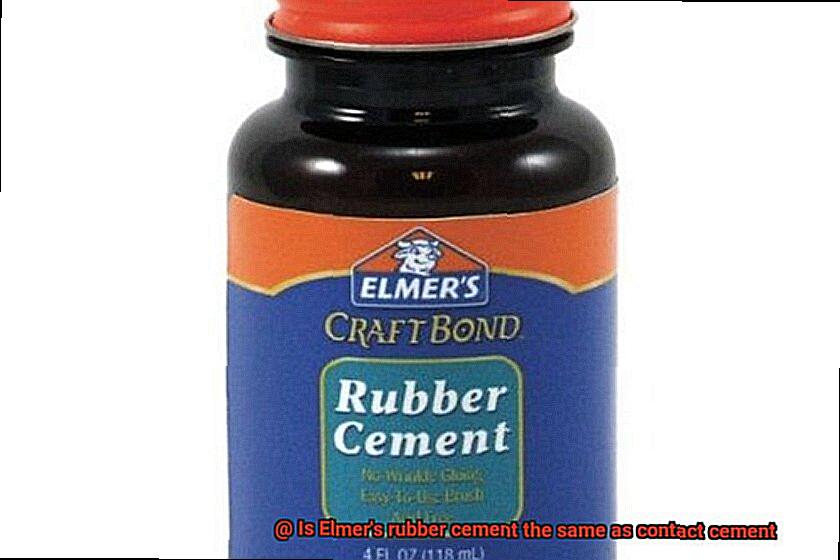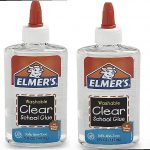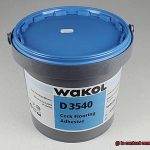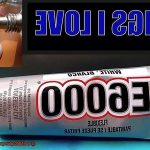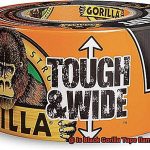Are you on a quest to find the ultimate adhesive for your next creative endeavor or repair project? With so many options out there, it’s easy to get lost in the sticky sea of choices. But fear not. In this blog post, we’re diving deep into the world of adhesives to answer one burning question – is Elmer’s rubber cement the same as contact cement? Prepare yourself for an enlightening journey as we explore their similarities, differences, and ideal applications, so you can make informed decisions for your DIY ventures.
Let’s start by debunking the myth that these two adhesives are identical. While both are commonly used in crafting, they have distinct compositions that result in unique functionalities.
Elmer’s rubber cement, true to its name, is primarily made up of rubber compounds dissolved in a solvent. Its low viscosity and impressive tackiness make it perfect for bonding lightweight materials like paper, cardboard, and fabrics. Need to adjust your project mid-assembly? No problem. Elmer’s rubber cement allows for easy repositioning without compromising its adhesive power.
Now let’s turn our attention to contact cement – a mighty adhesive created from synthetic rubber or polychloroprene mixed with solvents like acetone or toluene. Unlike Elmer’s rubber cement, contact cement forms an instant bond upon contact with materials such as wood, plastic laminates, metal, and leather. Its strength and rapid drying time make it ideal for heavy-duty projects where durability is key.

So which one should you choose? Well, it all depends on the nature of your task at hand. If you’re working on a school project that requires frequent adjustments or need to adhere delicate fabrics or lightweight materials together seamlessly, Elmer’s rubber cement is your go-to option. Its gentle yet reliable adhesive properties will ensure your creations stay intact without any fuss.
On the other hand, if you’re tackling a project that demands a steadfast and permanent bond, like assembling furniture or joining leather parts, contact cement is your trusty sidekick. Its rock-solid grip and lightning-fast drying time will give your projects the strength they need to withstand the test of time.
To bring it all to life, let’s explore some practical applications. Elmer’s rubber cement is perfect for collage-making, scrapbooking, or repairing torn book pages. Its ability to create temporary bonds that can be easily adjusted makes it
What is Elmer’s Rubber Cement?
Contents
- 1 What is Elmer’s Rubber Cement?
- 2 What is Contact Cement?
- 3 Comparison of Elmer’s Rubber Cement and Contact Cement
- 4 Composition of Elmer’s Rubber Cement and Contact Cement
- 5 Drying Time of Elmer’s Rubber Cement and Contact Cement
- 6 Strength of Elmer’s Rubber Cement and Contact Cement
- 7 Intended Applications for Elmer’s Rubber Cement and Contact Cement
- 8 Safety Considerations for Using Elmer’s Rubber Cement and Contact Cement
- 9 Conclusion
Elmer’s Rubber Cement is not your ordinary adhesive. It is a versatile and beloved choice for crafters, artists, and DIY enthusiasts alike. With its unique properties and temporary bonding capabilities, this glue opens up a world of creative possibilities. In this article, we will delve into the features and benefits of Elmer’s Rubber Cement, from its repositionability and low odor to its compatibility with porous materials.
A Temporary Bond with Repositionability:
One of the standout features of Elmer’s Rubber Cement is its ability to provide a temporary bond that allows for easy adjustments. Whether you’re working on a collage or experimenting with different layouts in scrapbooking, this glue lets you lift off and reposition your materials without causing any damage. No more fear of making mistakes or being stuck with a permanent bond.
Low Odor for a Pleasant Crafting Experience:
Unlike some other adhesives that come with strong and unpleasant smells, Elmer’s Rubber Cement offers a milder scent. This makes it more enjoyable to work with, especially for those sensitive to odors. You can focus on your creative process without any overpowering smells lingering in the air.
Compatibility with Porous Materials:
Elmer’s Rubber Cement excels when it comes to bonding porous surfaces such as paper, fabric, and cardboard. Whether you’re creating intricate paper crafts, designing personalized cards, or constructing collages, this adhesive has got you covered. Its ability to dry clear ensures no visible residue is left behind, maintaining the aesthetic appeal of your projects.
Considerations and Alternatives:
While Elmer’s Rubber Cement is perfect for temporary bonding on porous materials, it may not provide a strong enough bond on non-porous surfaces like glass or metal. For such applications, contact cement is often recommended. Contact cement offers a stronger and more durable bond, making it suitable for heavy-duty projects in construction and woodworking.
What is Contact Cement?
Look no further than contact cement. This remarkable adhesive is a game-changer in the world of bonding, providing a robust and enduring connection between various materials. In this article, we will explore the wonders of contact cement and why it is the go-to choice for professionals and DIY enthusiasts alike.
Unleashing the Power of Contact Cement:
- The Perfect Blend: Contact cement is meticulously crafted from a special blend of natural or synthetic rubber and potent solvents. This unique combination gives it a liquid consistency that effortlessly applies, ensuring a smooth and hassle-free experience.
- The Magic of Instant Bonding: Unlike traditional glues, contact cement requires both surfaces to be coated before they are pressed together. Once these surfaces make contact, the adhesive springs into action, creating an instantaneous bond that holds firmly.
- Versatility Redefined: From wood to metal, plastic to fabric, contact cement works its magic on almost any material. Whether you’re working on woodworking projects or laminating countertops, this adhesive has got you covered.
- Durability at Its Finest: Heat, water, chemicals – contact cement laughs in the face of challenges. Its resistance to these elements makes it ideal for projects that demand long-lasting results, even under heavy loads or constant stress.
- Porous or Non-Porous? No Problem: Contact cement does not discriminate. It effortlessly bonds both porous and non-porous surfaces, giving you the freedom to tackle any project without limitations.
Elmer’s Rubber Cement vs. Contact Cement:
While Elmer’s rubber cement has its place in the crafting world, it simply can’t compete with the power-packed performance of contact cement. Elmer’s rubber cement is perfect for temporary bonding and paper crafts, but when it comes to permanent, robust bonds on various materials, contact cement takes the crown.
Comparison of Elmer’s Rubber Cement and Contact Cement
When it comes to picking the perfect adhesive for your next project, there are a few crucial factors to consider. Elmer’s Rubber Cement and Contact Cement are two popular options, each with their own distinctive qualities and applications. In this article, we’ll delve into the disparities between these two types of glue to help you make an educated decision.
Let’s start with Elmer’s Rubber Cement. Crafted from natural rubber latex, this adhesive creates temporary bonds that allow for repositioning and easy removal. It’s a dream come true for crafts, scrapbooking, and collage projects that demand flexibility. And the best part? Elmer’s Rubber Cement dries in a flash, making it a convenient choice for those tight deadlines.
Now, let’s shift our attention to Contact Cement. This adhesive is a whole different animal. Once it dries, it forms an unbreakable bond that lasts a lifetime. That’s why it’s the go-to glue for woodworking, construction, and automotive projects. Its durability is unmatched. However, keep in mind that Contact Cement takes a bit longer to fully cure.
The application methods for these two adhesives also differ. With Elmer’s Rubber Cement, you brush it onto the surface with ease. On the other hand, Contact Cement can be applied using either a brush or a roller. This distinction is worth noting depending on the nature of your project.
Flexibility is another factor to consider. Elmer’s Rubber Cement offers more wiggle room compared to Contact Cement. If you’re working on crafts or bookbinding that require some movement or bending, Elmer’s Rubber Cement is the way to go. But if you need a rock-solid bond that can withstand anything, Contact Cement is your best bet.
Composition of Elmer’s Rubber Cement and Contact Cement
When it comes to glue, not all adhesives are created equal. Two popular choices, Elmer’s Rubber Cement and Contact Cement, have distinct compositions that make them ideal for different types of projects. Let’s dive deeper into their composition and applications to understand what sets them apart.
Elmer’s Rubber Cement, a favorite among crafters and scrapbook enthusiasts, contains natural rubber latex, petroleum distillates, and other additives. The natural rubber latex acts as the primary adhesive component, providing strong bonding properties. Meanwhile, the petroleum distillates derived from petroleum make the rubber cement more liquid and easy to spread.
On the other hand, Contact Cement is commonly used in woodworking and construction projects due to its incredible bonding strength. Unlike Elmer’s Rubber Cement, Contact Cement contains synthetic polymers like neoprene or polychloroprene, along with solvents. These synthetic polymers are responsible for providing the adhesive properties of Contact Cement, while the solvents ensure it remains in a liquid state until it dries.
The differences in composition result in different application methods and purposes for these two adhesives. Elmer’s Rubber Cement is typically applied by spreading a thin layer on one or both surfaces to be bonded and allowing it to dry before joining them together. This makes it perfect for temporary bonds that can be easily removed or repositioned.
In contrast, Contact Cement is applied to both surfaces to be bonded and allowed to dry until it becomes tacky. Once the surfaces are pressed together, an instant and permanent bond is formed. This makes Contact Cement ideal for heavy-duty applications where a strong and lasting bond is required.
However, it is important to consider safety when working with these adhesives. Both Elmer’s Rubber Cement and Contact Cement contain solvents that can be flammable and emit harmful fumes if inhaled excessively. It is crucial to use these adhesives in well-ventilated areas and follow the safety instructions provided by the manufacturers.
Drying Time of Elmer’s Rubber Cement and Contact Cement
When it comes to completing your craft project or repair job, time is of the essence. That’s why understanding the drying times of Elmer’s Rubber Cement and Contact Cement is crucial in making the right adhesive choice. Let’s delve into the specifics and uncover the secrets behind these two popular adhesives.
Elmer’s Rubber Cement, known for its quick-drying nature, is the go-to option for those who want to get things done in a flash. Within a mere 15 to 30 minutes, this adhesive dries and allows you to move forward with your project without delay. Whether you’re scrapbooking or creating a temporary bond, Elmer’s Rubber Cement provides efficiency and convenience.
On the other hand, Contact Cement requires a bit more patience. It typically takes at least 15 to 30 minutes to dry before you can bond surfaces together. However, for optimal results and maximum bond strength, it is recommended to wait a full 24 hours before applying any pressure or stress on the materials. This adhesive is perfect for construction projects or when you need a sturdy and permanent bond that can withstand heavy loads or exposure to moisture.
But here’s the clincher – both Elmer’s Rubber Cement and Contact Cement continue to cure and strengthen over time. So even if they may be dry to the touch within their respective drying times, it’s essential to give them sufficient curing time for maximum bond strength. Patience truly is a virtue when it comes to achieving the best results.
To make an informed decision between Elmer’s Rubber Cement and Contact Cement, consider the specific requirements of your project. If you need a quick-drying adhesive for lightweight materials or temporary bonds, Elmer’s Rubber Cement is your ideal choice. On the other hand, if you’re seeking a robust and long-lasting bond that can withstand heavy loads or exposure to moisture, Contact Cement is the way to go.
Remember to always follow the manufacturer’s instructions regarding drying and curing times for both adhesives. These guidelines can usually be found on the product packaging or the manufacturer’s website. And of course, handle these powerful adhesives with caution, ensuring proper ventilation and adherence to safety instructions.
Strength of Elmer’s Rubber Cement and Contact Cement
When it comes to bonding power, Elmer’s Rubber Cement and Contact Cement are two heavy hitters. While they may seem similar, each glue has its own unique strengths that make it perfect for different applications.
Let’s start with Elmer’s Rubber Cement. This glue is a favorite among crafters and scrapbookers for a reason – it’s flexible and repositionable. Imagine sticking something down temporarily, only to realize later that you need to move it. With Elmer’s Rubber Cement, that’s not a problem. It may not have the same strength as Contact Cement, but it still provides adequate adhesion for lightweight materials.
Now, let’s talk about Contact Cement. This stuff is the real deal. It’s the go-to glue for woodworking, laminating, and other projects that demand a durable bond. When two coated surfaces come into contact with each other, Contact Cement forms an instant bond. No more waiting around for glue to dry – you can get right to work.
Contact Cement takes the crown for versatility. It can adhere to wood, metal, plastic, and even fabric. Elmer’s Rubber Cement, on the other hand, is primarily designed for use on paper, cardboard, and lightweight materials.
Keep in mind that the strength of both glues can be influenced by factors like surface preparation, application technique, and drying time. To ensure optimal bonding strength, follow the manufacturer’s instructions and properly prepare your surfaces before applying the adhesive.
Intended Applications for Elmer’s Rubber Cement and Contact Cement
Glue may seem like a small detail, but it can make or break a project. Whether you’re a creative crafter or a DIY enthusiast, having the right adhesive is crucial. In this blog post, we’ll dive into the intended applications of two popular glues – Elmer’s Rubber Cement and Contact Cement. Let’s discover which one suits your next project best.
Elmer’s Rubber Cement – The Crafty Sidekick:
Imagine having a glue that embraces your creativity and allows for change. Elmer’s Rubber Cement is the ultimate crafty sidekick, perfect for projects that require repositioning. Its temporary bond is ideal for crafting, scrapbooking, and model building. You can easily adhere paper, cardstock, fabric, and lightweight materials with ease. The best part? The precision and control it offers. You can make adjustments before the adhesive fully sets. And when it’s time for a change, simply remove it with an eraser or peel it off the surface. With Elmer’s Rubber Cement, your imagination knows no bounds.
Contact Cement – The Superhero of Adhesives:
If you’re in need of a glue that means business, Contact Cement is your superhero. It was designed for woodworking, construction, and automotive projects that require strength and durability. With its incredible bond strength and resistance to heat and moisture, Contact Cement is a reliable choice. Once the surfaces come into contact with each other, it forms an instant bond, leaving little room for repositioning.
This adhesive works wonders on a wide range of materials like wood, metal, plastic, and laminate. However, be prepared for its strong odor and remember to work in a well-ventilated area or wear a mask.
Safety Considerations for Using Elmer’s Rubber Cement and Contact Cement
Safety is of utmost importance when using Elmer’s rubber cement and contact cement. These adhesives, commonly used in crafts, woodworking, and construction projects, require careful handling to prevent any accidents or health risks. Understanding their properties, application techniques, storage requirements, and potential hazards is crucial for safe usage.
Elmer’s Rubber Cement:
- Rubber cement is generally considered safer than contact cement due to its lower toxicity levels and less hazardous chemical composition.
- However, some individuals may be allergic to natural rubber latex, which is a common ingredient in rubber cement.
- To prevent skin irritation or allergies, it is best to avoid direct skin contact and use protective gloves when handling this adhesive.
- If an allergic reaction occurs, seek medical attention immediately.
Contact Cement:
- Contact cement contains more volatile solvents and strong chemicals like toluene and acetone.
- These substances can be harmful if inhaled or absorbed through the skin.
- Always use contact cement in a well-ventilated area to minimize the risk of inhaling fumes.
- Wearing a respirator or mask is recommended for added protection.
- In case of accidental ingestion or inhalation, seek immediate medical attention, and bring the product label or container for reference.
Storage Requirements:
- Both rubber cement and contact cement are flammable and should be stored in a cool, dry place away from heat sources and open flames.
- High temperatures can cause these adhesives to ignite, leading to dangerous situations.
- Proper storage ensures the longevity of the products while minimizing fire hazards.
Application Techniques:
- Follow the manufacturer’s instructions carefully when using either type of adhesive.
- Use the correct amount of glue for your project to ensure proper bonding.
- Apply the adhesive in a well-controlled manner to avoid spills or excessive exposure.
- Allow sufficient drying time before handling the bonded materials.
xaKys5ZjCaY” >
Conclusion
Elmer’s rubber cement and contact cement may seem similar, but they are not the same. While both are adhesives, they have different compositions and uses.
Elmer’s rubber cement is a type of adhesive that is made from natural rubber. It is commonly used for crafts, scrapbooking, and other lightweight projects. This type of cement is known for its ability to bond paper, fabric, and other porous materials together.
On the other hand, contact cement is a stronger adhesive that is typically used for heavy-duty applications. It is made from synthetic polymers and solvents. Contact cement forms an instant bond when two surfaces coated with it come into contact with each other. This makes it ideal for bonding materials such as wood, laminate, metal, and plastic.
So while Elmer’s rubber cement and contact cement both serve as adhesives, they have different compositions and purposes. It’s important to choose the right type of adhesive based on your specific project requirements to ensure optimal results.
In conclusion, Elmer’s rubber cement is not the same as contact cement. They differ in composition and usage.

